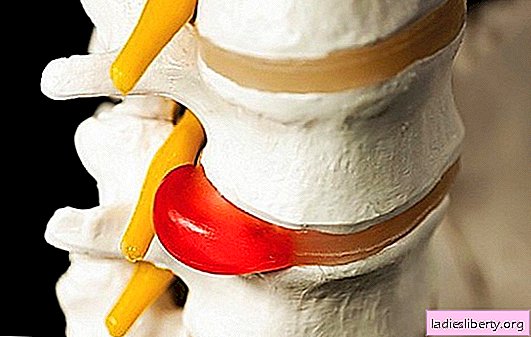
According to statistics, every 10 people in the world suffer from diseases of the musculoskeletal system. This is a significant figure. Only cardiovascular pathologies are more common.
Intervertebral hernias account for up to 15% of all visits to a neurologist or neurosurgeon.
Unfortunately, this disease often leads to disability. This is a huge problem for any society: pathology excludes a person from work, becomes a dictator and subjugates the patient. However, such an outcome can be avoided, the main thing is to know the enemy in person.
What is intervertebral hernia
Intervertebral hernia is a pathology of the musculoskeletal system, in which there is a partial or complete protrusion of the pulpous nucleus of the intervertebral disc outward or outward. Most often, hernias are formed as a complication of osteochondrosis. This disease is even more common. Its course is associated with dystrophic processes in the spinal column. At a certain point, the fibrous ring holding the core of the intervertebral disc breaks. The disk is deformed and becomes unable to perform a cushioning function.
Herniated discs are distinguished by their danger, so in no case should you do anything yourself.
Causes of intervertebral hernias of the lumbar spine
The reasons are numerous. We give only the most common:
• Burdened by heredity. Disc hernias are not inherited. Only structural features of the musculoskeletal system are transmitted, and therefore a predisposition to pathologies of the musculoskeletal structures of the spine. If one parent suffers from a hernia, the risk of getting sick rises to 5%. Both are 12-15%. However, these are not unconditional figures. It all depends on the patient’s habits.
• Excessive exercise. Persons engaged in heavy physical labor are at much greater risk. Not only and not so much dynamic loads are dangerous. Static loads are much more dangerous, under which the disks are subjected to a higher voltage. Also, sharp, twitching attempts to lift a heavy load lead to hernias. This is the most common cause of lumbar intervertebral hernias.
• Taking certain medications. Glucocorticosteroids, some antibacterial drugs lead to the destruction of bone structures. The spine weakens, the fibrous ring of the disk is torn, which leads to the formation of the described pathology.
• Lack of exercise. It leads to a weakening of the muscle corset, as a result - the spine becomes unstable.
• Adverse environmental conditions. It acts as an indirect cause of the formation of intervertebral hernias.
• Prolonged stay in an uncomfortable position, for example, in the process of sleep.
• Obesity. It leads to an increase in the load on the lumbar spine. Overweight is the enemy of the spine.
Risk groups
Some categories of people suffer from intervertebral hernias more often. Who are these people?
• Professional athletes.
• Persons professionally engaged in manual labor.
• Elderly patients.
• Persons who are overweight.
• Office workers.
The first symptoms of an intervertebral hernia of the lumbar spine
There are many signs of an intervertebral hernia of the lumbar spine. Among them:
• Pain syndrome. A constant companion of an individual suffering from intervertebral hernia. The pains are usually aching, pulling, giving (radiating) to one or both legs on the back side. The pain spreads from the lumbosacral zone along the legs up to the foot. A particularly severe pain syndrome develops if hernias pinch the sciatic nerve. This does not happen so rarely. This condition has a medical name - sciatica. The pain intensifies while wearing heavy loads, physical exertion.
• Feeling of numbness in the lumbar region. An uncomfortable sensation can be localized in the lumbar region, and can spread to the legs. This is a very bad sign of an intervertebral hernia of the lumbar spine, since we are talking about pinched nerve roots. If this condition is not stopped in time, the roots will begin to die, and the sensitivity of the legs will decrease. Acts among the first symptoms of a lumbar hernia.
• Feeling of goosebumps running on back and legs. It develops for the same reason as the feeling of numbness: all the fault is the pinched nerve endings.
• Decreased motor activity of the lower extremities. As a result of infringement of the nerve roots, a decrease in the motor activity of the legs occurs. This symptom increases with the size of the hernia. A similar situation has been caused by compression of the nerve roots and spinal cord.
• Complete loss of leg sensitivity. It is rare. Evidence in favor of spinal cord compression. Extremely dangerous symptom.
• In advanced cases, observed urinary and / or fecal incontinence.
Diagnosis of intervertebral hernia
Diagnosis of diseases of the musculoskeletal system as a whole is carried out by orthopedists. However, disc herniation is an interdisciplinary problem. Do not do without consulting a neurologist and, in extreme cases, a neurosurgeon. However, you should start your journey by visiting a general practitioner or surgeon. They will help determine the further strategy of the survey and will give the necessary directions.
The basis of diagnosis is instrumental research. Among the most informative:
1) Radiography of the lumbar spine. The most common and affordable study. The main disadvantage is the lack of visualization of soft tissues and structures, which include intervertebral discs. In this case, one can only guess if there is a hernia or not.
2) MRI diagnostics. The most preferred method to detect changes in the spine with one hundred percent accuracy.
Usually, these studies are enough to identify pathologies of the spine.
Treatment of intervertebral hernias of the lumbar spine
In the case of therapy, conservative methods of treatment play an important role. Surgical treatment is an extreme measure, so if the doctor offers surgery from the doorway, this is an occasion to reflect on his competence.
The basis of conservative therapy is the use of special medicines:
• Anti-inflammatory non-steroidal origin. These include: Ketorol, Nise, Ibuprofen, Nimesulide, Ksefokam, etc.
• Anesthetics: Movalis, Baralgin, etc.
• Antispasmodics (No-shpa).
• muscle relaxants.
In extreme cases, the use of steroidal anti-inflammatory drugs (Prednisone and others like that) is indicated.
With the transition of the disease in a state of remission, physiotherapy and exercise therapy are prescribed. Specific procedures and complexes of physical exercises are selected by doctors based on the severity of the disease and the current condition of the patient. Orthopedic treatment is widely practiced. Its essence lies in wearing a special tire that artificially supports the diseased spine. Treatment of intervertebral hernia of the lumbar spine should be comprehensive, only then the effect will be most noticeable.
Prevention of intervertebral hernia of the lumbar spine
Preventive measures are easy to implement.
• First of all, it is recommended to optimize physical activity. Overwork is not worth it, just as it is not recommended to sit in one place for too long.
• If you need to lift a heavy load, do not jerk it. It should lift weights smoothly.
• It is recommended to eat foods rich in calcium.
• You should also lose weight.
Prevention of intervertebral hernia of the lumbar spine is not very difficult. However, thanks to these simple recommendations, the risk of developing pathology can be minimized.
Doctor's Frequently Asked Questions and Answers
Is intervertebral hernia treated?
Yes, this disease is potentially treatable. Usually, when such a pathology is detected, doctors take a wait-and-see tactic, recommend conservative treatment, and only with a significant deterioration in the condition, surgery is indicated. However, today there are many methods of minimally invasive treatment, including laser therapy, etc.
What can and cannot be done with hernias?
It is not recommended to lift weights above 10-15 kg for men and 7-10 for women. Otherwise, there is a high risk of infringement of the nerve endings. It will end in a hospital. You can not steam in the bath, sit in a hot bath for a long time. You can adhere to the optimal regime of physical activity.
Can I relieve pain on my own?
You can, but do not get too carried away with anti-inflammatory. The acceptable course for pain relief is 3 days, taking anti-inflammatory, 3 days taking analgesics. But this measure is taken only to relieve pain, then to visit a doctor.
But what about sports?
Swimming is acceptable. All other sports, especially power sports, are strictly prohibited.
Is it possible to warm hernias?
In no case. As well as cooling. This is fraught with complication of the situation.
Is it possible to do massage?
In the acute period in no case. During remission - a decision is made on an individual basis.
Hernia of the lumbar spine - a dangerous disease. There is always a risk of disability. Therefore, it is important to undergo treatment in time and adhere to preventive measures.











